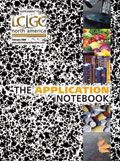LC–MS-MS Analysis of Malachite Green, Leucomalachite Green, Ciprofloxacin, and Tetracycline in Food Samples Using an Online TurboFlow LC–MS Method
The Application Notebook
The analysis of chemical residues in food requires techniques sensitive enough to detect and quantify contaminants at or below the maximum residue limit (MRL) of the compound in a given sample matrix. Because of increased food safety regulations and the growing numbers of samples to be analyzed, it is critical that the analytical techniques provide high sample throughput.
The analysis of chemical residues in food requires techniques sensitive enough to detect and quantify contaminants at or below the maximum residue limit (MRL) of the compound in a given sample matrix. Because of increased food safety regulations and the growing numbers of samples to be analyzed, it is critical that the analytical techniques provide high sample throughput.
In this study, ciprofloxacin, tetracycline, and malachite green/leucomalachite green were examined in shrimp, fish, and pork liver. We show a solution that combines the Thermo Scientific Aria TLX system utilizing TurboFlow™ technology with a Thermo Scientific TSQ Quantum Access mass spectrometer. Compared to traditional offline extraction methods, this solution provides fast and reliable sample analysis of chemical residues in food by online sample extraction followed by LC–MS-MS. The Aria™ TLX system uses TurboFlow technology to retain small molecules and filter out proteins and larger materials by diffusion, size exclusion, and column chemistry. This enables users to directly inject samples into the LC–MS system for analysis, greatly simplifying sample preparation and increasing throughput.
MS Conditions
MS analysis was carried out on a TSQ Quantum Access™ triple stage quadrupole mass spectrometer.

Table I: Improvement in the TurboFlow method results over those of the standard HPLC results. Note that results are only shown for a compound in the matrix in which it would be found; for example, MG and LMG would be found in fish but not in pig liver.
Results and Discussion
The results of the assay and a comparison between standard HPLC method without any sample cleanup versus TurboFlow LC–MS method with online sample cleanup are shown in Table I. An example chromatogram is shown in Figure 1. Because the TurboFlow method removed matrix interferences, lower limits of detection (LOD) and lower limits of quantitation (LOQ) were obtained than in the standard HPLC method (see Table I). The corresponding percent relative standard deviation values (%RSD) were also improved, providing more confidence in the results. The limits of detection and limits of quantitation were well below the maximum residue limits for all of the substances.

Figure 1: Chromatogram comparison of tetracycline at 500 ng/kg in pig liver matrix in standard HPLC and TurboFlow method.
Conclusion
A rapid, sensitive and reliable method for the quantitation of veterinary drugs in food matrices was developed using the Aria TLX-1 system with the TSQ Quantum Access mass spectrometer. Minimal sample preparation was required because the TurboFlow method allows direct injection of samples into the system. The Aria TLX system reduced ion suppression and matrix effects compared to standard HPLC runs.

Thermo Fisher Scientific, Inc.
355 River Oaks Parkway, San Jose, CA 95134-1991
tel. (800)532-4752, fax (561)688-8731
Website: www.thermo.com

Analytical Challenges in Measuring Migration from Food Contact Materials
November 2nd 2015Food contact materials contain low molecular weight additives and processing aids which can migrate into foods leading to trace levels of contamination. Food safety is ensured through regulations, comprising compositional controls and migration limits, which present a significant analytical challenge to the food industry to ensure compliance and demonstrate due diligence. Of the various analytical approaches, LC-MS/MS has proved to be an essential tool in monitoring migration of target compounds into foods, and more sophisticated approaches such as LC-high resolution MS (Orbitrap) are being increasingly used for untargeted analysis to monitor non-intentionally added substances. This podcast will provide an overview to this area, illustrated with various applications showing current approaches being employed.

.png&w=3840&q=75)

.png&w=3840&q=75)



.png&w=3840&q=75)



.png&w=3840&q=75)
















